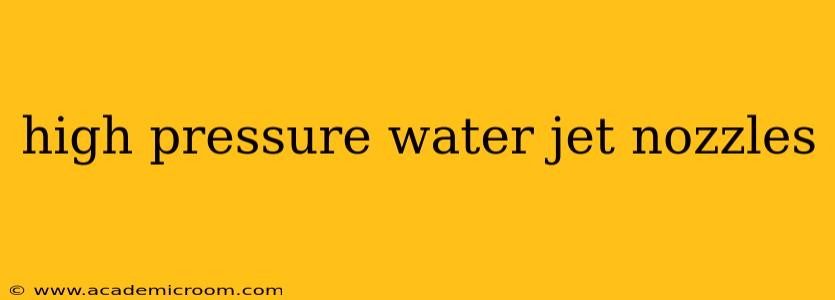High-pressure water jet nozzles are precision-engineered devices that transform high-pressure water into a powerful, focused stream. This technology finds applications across a wide range of industries, from industrial cleaning to precise cutting and material removal. Understanding the nuances of these nozzles is crucial for selecting the right tool for the job. This comprehensive guide delves into the intricacies of high-pressure water jet nozzles, exploring their types, applications, and critical considerations for effective use.
What are the Different Types of High-Pressure Water Jet Nozzles?
High-pressure water jet nozzles come in various designs, each optimized for specific tasks and pressure ranges. The most common types include:
-
Rotating Nozzles: These nozzles utilize a rotating head to create a wider cleaning pattern, increasing efficiency for large-area cleaning tasks. The rotation also helps prevent localized damage to surfaces.
-
Fixed Nozzles: As the name suggests, these have a stationary orifice, delivering a concentrated, high-velocity stream ideal for precise cutting, cleaning, and material removal. The orifice size dictates the stream's diameter and intensity.
-
Fan Nozzles: These produce a flat, fan-shaped spray pattern, useful for surface cleaning and coating applications where a broader coverage area is required while still maintaining sufficient pressure.
-
Multiple-Orifice Nozzles: Featuring multiple small orifices, these nozzles distribute the water flow over a larger area, providing effective cleaning with reduced erosion potential compared to single-orifice nozzles.
-
Special Purpose Nozzles: This category encompasses nozzles designed for highly specialized applications such as hydrodemolition, where specialized designs are crucial for controlled material removal.
How Does the Pressure Affect High-Pressure Water Jet Nozzles?
The pressure of the water jet directly impacts the nozzle's performance and the outcome of the application. Higher pressures deliver greater cutting power and cleaning efficiency, but also increase the risk of damage to surfaces or equipment if not handled carefully. The nozzle's design must be compatible with the operating pressure to ensure both optimal performance and longevity. Incorrect pressure matching can lead to premature wear or nozzle failure.
What are the Common Applications of High-Pressure Water Jet Nozzles?
The versatility of high-pressure water jet nozzles makes them indispensable across diverse industries. Some key applications include:
-
Industrial Cleaning: Removing dirt, grime, paint, and other contaminants from various surfaces, including machinery, vehicles, and infrastructure.
-
Surface Preparation: Cleaning surfaces before painting, coating, or welding to ensure proper adhesion.
-
Material Cutting: Precisely cutting various materials, including metals, stone, and composites, with minimal heat generation.
-
Hydrodemolition: Controlled demolition of concrete structures, removing deteriorated concrete without damaging the underlying reinforcement.
-
Descaling: Removing scale buildup from pipes, equipment, and other surfaces.
What Materials are High-Pressure Water Jet Nozzles Made From?
The material selection for high-pressure water jet nozzles is critical for durability and longevity. Common materials include:
-
Tungsten Carbide: Exceptionally hard and wear-resistant, ideal for high-pressure applications and abrasive materials.
-
Ceramic: Offers excellent corrosion resistance and hardness, suitable for demanding environments and applications.
-
Steel: A more affordable option, suitable for lower-pressure applications where extreme hardness is not essential. Often hardened to enhance durability.
How to Choose the Right High-Pressure Water Jet Nozzle?
Selecting the appropriate high-pressure water jet nozzle requires careful consideration of several factors:
-
Operating Pressure: Match the nozzle's pressure rating to the water jet system's capabilities.
-
Flow Rate: The desired flow rate will influence the nozzle's size and design.
-
Application: The specific task will dictate the nozzle's type and spray pattern.
-
Material Compatibility: Choose a nozzle material resistant to the materials being cleaned or cut.
-
Durability Requirements: Consider the frequency of use and the abrasiveness of the materials being processed to select a durable nozzle.
What are the Safety Precautions When Using High-Pressure Water Jet Nozzles?
High-pressure water jets pose significant safety risks. Always follow these precautions:
-
Eye Protection: Wear appropriate safety glasses or face shields to protect against water spray and debris.
-
Hearing Protection: High-pressure water jets can generate significant noise, necessitating hearing protection.
-
Protective Clothing: Wear protective clothing to prevent injuries from water spray or high-velocity particles.
-
Proper Training: Ensure operators are properly trained in the safe operation and maintenance of high-pressure water jet systems.
-
Regular Inspections: Inspect nozzles and equipment regularly for wear and tear to prevent malfunctions.
By carefully considering these factors and adhering to safety protocols, you can harness the power of high-pressure water jet nozzles effectively and safely for a wide variety of applications. Remember that proper selection and responsible usage are key to maximizing efficiency and minimizing risks.
